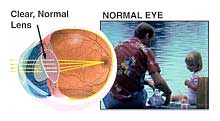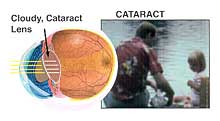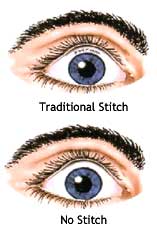For more information, or to schedule an appointment for consultation or SLT cold laser glaucoma surgery at our practice, please fill out the contact form below. Dr. Jindra and the staff are more than happy to address any concerns you may have.
Dr. Lawrence F. Jindra
5 Covert Ave
Floral Park, New York 11001
United States of America
Ph / +1.516.616.1710
Treating Cataracts in New York City and Long Island
Dr. Lawrence F. Jindra has great experience performing cataract surgery and treating cataracts. Based in Long Island, Dr. Jindra can provide you with all of the information you need about cataracts so you can make an informed decision about your vision correction options.
Cataracts FAQs
- What are cataracts?
- Who gets cataracts?
- What causes cataracts?
- How can a person avoid cataracts?
- What symptoms are associated with cataracts?
- How are cataracts treated?
- Is cataract surgery the only way to treat cataracts?
- When will I need to have my cataracts removed?
- What happens after cataract surgery?
- Is cataract surgery safe?
What are cataracts?


A cataract is the clouding of the lens of the eye that occurs as part of the natural aging process. When cataracts develop, they block the normal passage of light through the eyes, resulting in blurred or distorted vision.
< back
Who gets cataracts?
Cataracts are typically found in people over 55 years of age, but can occasionally develop in younger individuals, even newborns. The only way to know for sure if you have a cataract is to visit your doctor for an eye examination. Dr. Jindra works with cataracts patients to develop effective treatment plans for this condition.
< back
What causes cataracts?
A wide variety of factors can cause cataracts to develop. Various chemical changes within the eye caused by injury, disease, or genetics can cause the lens to turn cloudy. Excessive or prolonged exposure to ultraviolet radiation from sunlight, medications, or cigarette smoke can also contribute to the development of cataracts.
< back
How can a person avoid cataracts?
While there are no proven ways to prevent the formation of cataracts, quitting smoking, reducing sun exposure, and eating a balanced, healthy diet may help prevent the development of cataracts.
< back
What symptoms are associated with cataracts?
Some early indicators that cataracts may be forming include decreased perception of color, hazy or blurry vision, and the sensation of having a film covering your eyes. Other signs that cataracts may be forming are increased sensitivity to glare, particularly at nighttime, and temporary improvement in vision of nearby objects. Common symptoms of cataracts include blurred vision, double vision, acute sensitivity to glare of bright light, and the yellowing or dimming of colors.
< back
How are cataracts treated?
If your cataracts affect your normal everyday activities, cataract surgery will be recommended at our Long Island office, serving all of New York City. The cataract surgery will be performed at the Ambulatory Surgical Unit of Winthrop University Hospital. Cataract surgery can generally be performed in an outpatient setting using a local or topical anesthesia. Using phacoemulsification through a small incision, Dr. Jindra extracts the clouded lens, replacing it with an intraocular lens (IOL) implant. The implants are usually inserted through the small incision and unfolded into the eye. The IOL implants can even be multifocal, with several different focal ranges for distant, intermediate, and near vision. There are usually no stitches required to close this self-sealing incision. Medication is generally placed in the eye after cataract surgery and a patch is usually not required.
< back
Is cataract surgery the only way to treat cataracts?
Because cataracts progress gradually, Dr. Jindra can issue new prescription eyewear to correct your vision until cataract surgery is required. However, when the eyewear can no longer adequately improve your eyesight, cataract surgery is the only way to properly treat cataracts.
< back
When will I need to have my cataracts removed?
Cataracts can be removed at any stage in their development, though many opt for cataract surgery when the cataracts interfere with daily activities. Dr. Jindra works with each patient to determine when cataract surgery is appropriate. At his office, all of Dr. Jindra's patients receive care tailored to their individual needs. Typically, however, cataract surgery may be required when a patient experiences difficulty reading, driving, or watching television, or otherwise feels unsafe or uncomfortable as a result of impaired vision.
< back
What happens after cataract surgery?
Following cataract surgery, you will need to have several follow-up evaluations by Dr. Jindra to monitor the healing process. When cataract surgery is completed, contact lenses or eyeglasses may be prescribed to provide the most effective post-cataract vision. Many patients, however, find that their vision improves naturally following cataract surgery. During the initial healing period following cataract surgery, you may be asked to avoid any strenuous activity. Many patients will return to their normal lifestyles shortly after surgery.
< back
Is cataract surgery safe?
Yes, cataract surgery is relatively safe. However, all surgical procedures involve some risk. Dr. Jindra carefully discusses possible complications to cataract surgery patients, ensuring that they are informed about their treatment choice. Additionally, our practice takes every precaution to minimize the risk of undesirable side effects from cataract surgery.
< back
To learn more about cataracts or cataract surgery, please contact our ophthalmology practice today.
» top
No-Stitch Cataract Surgery

Dr. Jindra performs no-stitch, small incision cataract surgery at the Ambulatory Surgical Center at Garden City of Winthrop University Hospital. Cataract surgery is a safe and effective way to successfully treat cataracts. During no-stitch cataract surgery, the beveled, self-sealing incision is placed in the cornea (clear part of the eye) just next to the sclera (white part of the eye).
Phacoemulsification
Through a small, one-eight-inch incision, Dr. Jindra inserts the phacoemulsification probe into the eye to perform the cataract extraction. Phacoemulsification is an advanced intraocular microsurgical procedure for the removal of cataracts. At the Ambulatory Surgical Center at Garden City of Winthrop University Hospital, this delicate microsurgery is performed using state-of-the-art, computerized ultrasound technology. The cloudy lens is gently emulsified into tiny pieces which are then vacuumed and aspirated from the eye. To accomplish this, Dr. Jindra uses a cutting-edge computerized instrument with a surgical probe, about the size of a ballpoint pen tip, that vibrates approximately 40,000 times per second.
A special foldable replacement lens can then be implanted through this small incision. After cataract surgery, the surgical wound is usually watertight and generally requires no stitch to close.
Intraocular Lens Implant
Once the cataract has been removed during cataract surgery, the most effective way to restore vision is to replace the cloudy lens with a clear, artificial intraocular lens (IOL) implant.
An IOL implant is an artificial lens made of plastic, silicone, acrylic or other material; it is implanted inside the eye during cataract surgery. The IOL implant is generally placed within the lens capsule, a membranous pouch that provides permanent support for the lens. The IOL implant rests safely inside the eye and is never adjusted or handled by the patient.
Most patients with cataracts are good candidates for IOL implants and have the device implanted during cataract surgery.
Secondary cataracts
During cataract surgery at the Ambulatory Surgical Center at Garden City of Winthrop University Hospital, an IOL is placed in the lens capsule. This capsular bag is normally clear at the time of cataract surgery. In some patients, this clear capsule can turn cloudy in the months or years following cataract surgery. If this occurs, Dr. Jindra can perform an outpatient laser procedure that will quickly restore optimal vision at his office in Floral Park. Currently, this is the only instance in which a laser is used in a cataract-related situation.
After cataract surgery
The healing period following cataract surgery is generally three months. During that time, it is important to visit Dr. Jindra and to use your eye drops as prescribed. If you have received an IOL implant and experienced no complications following cataract surgery, you will probably notice vision improvement within a week. You can request temporary glasses following cataract surgery, but your final prescription will generally not be ordered until postoperative healing is complete. If you should experience any complications following cataract surgery, do not hesitate to contact our office.
Advantages of no-stitch cataract surgery
- No need to place or remove sutures
- Performed under just topical or local anesthesia
- Requires no protective patch when combined with topical or local anesthesia
- Usually a bloodless, self-sealing, clear-corneal incision
- Postoperative vision improves while simultaneously minimizing postoperative astigmatism
^ top
To learn more about cataracts or cataract surgery, please contact Dr. Lawrence F. Jindra's Floral Park ophthalmology practice today.